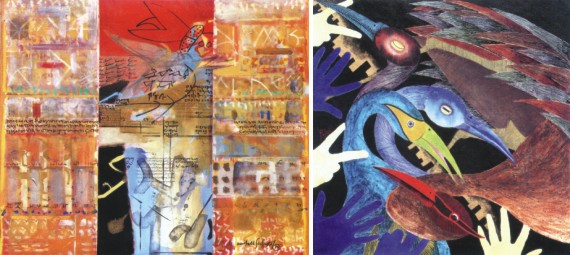Exhibition
Exchange of Ideas from Across the Border --
Fayza Haq
Amitabh Sen Gupta, who leads the Kolkata troupe of the "Dhaka -Kolkata" exhibition, says that he had

Sudeshna Halder, The Origin-1, Acrylic on canvas, 2007. |
come earlier to Bangladesh with his friends Prof.Anil Sarkar and artist Jaya Ganguli, a trip which Prof Anisuzzaman had organized for them. Sitting in the Bengal Gallery, where this exhibition is being held, Sen Gupta says," I'm originally from East Bengal although I was born in Kolkata. With time I got to know many and make friends. Later we did an art camp in Khulna, where artists came from Bangladesh and Kolkata. With time, senior artists came to Dhaka to plan and an exhibition of 40 artists, which was held in Kolkata. On November 2 there was yet another display of both young Bangladeshi and Kolkata artists in Kolkata. Thus exchanges of ideas of artists have been going on for some time. We hope to have seminars and art camps too."
Sen Gupta says culturally the artists of these two places don't have much of a difference: Our history is the same. People in Kolkata are well acquainted with Zainul Abedin and Safiuddin Ahmed. It is important to know the younger generation of artists. Every time we came here and each time artists from here went to Kolkata, there was a new flow of ideas. "It is vital that the exhibitions should be recorded, as is done in the west. There must be documentation and archives of what is being done and thought of by the artists. What we, as artists, coming from Kolkata find, is simply endless. We learn not only of paintings but songs, fiction, cookery, jams on the roads."

Rafiqun Nabi, Struggle, Woodcut, 2003. |
Asked to give his opinion of how the west evaluate our work, Sen Gupta says, that they are not fully acquainted with our work and some even feel that it is limited to miniature art etc. "Seeing our work they are amazed that we are so progressive, and so easily comprehensive to the western eyes. We cannot blame them for this as we have such limited documentation of our work, even in the form of art journals, that others in Europe could see and study," says Sen Gupta.
Sen Gupta, a painter, is also into graphics and digital art. Folk art also fascinates him, and he feels he could do considerable amount of research on that in Bangladesh.
Farida Zaman, on this occasion says," In my experience one learns a lot from such exchange of ideas. Although we say that in our paintings we should reflect our heritage and culture yet we cannot ignore other lifestyles and trends of thinking. One must have complete control of one's techniques and at the same time learn what others might have to teach us, in order to widen our horizons. Just as we go overseas to find out what is going on there, so we must try and make our own work interesting for others from overseas.
Qayyum Chowdhury, who also graced the press conference, says," There is a term 'Bengal Art' in this Subcontinent which has come down from the 18th century and has flowered with Rabindranath Tagore's family. In both east and west Bengal we are following a similar genre of art. There should be a revival of the golden art of the past."
The offerings at the exhibition are remarkable indeed. Arun Kumar Mondal's "Untitled-1", acrylic on canvas carries , bears two embracing lovers, with motifs of flowers and plants on the woman's dress, and ornate tropical forest all around. It is in shades of blue, green and yellow. Maloy Karmakar's "Nature Forest-1" in acrylic is another soothing scene from nature with a single tiny bird done in red in the forefront, with sweeps of brown and green in the backdrop.
The Girls" by Susanta Chakraborty is a fine piece of portrait in startling colours in splashes of blue and red. If one cared fro details and history one had only to see Apto Bhattacharya's "Old Kolkata". Shades of leaves and turns of arches and drops of showers of fountains were all caught in the web of the layers of burnt sienna and yellow.
Abdus Shakoor's "Four Faces" presented village women's faces in shades of blue and green, with tiny details of clothes and jewelry that set off the simple, radiant, faces. The four faces are framed in reds and greens of "lungi" checks. Rafiqun Nabi's woodcut "Struggle" presents action in simple black lines. The entwining couple in sepia brush and ink in Aminul Islam's "Homage to Khajuraho" is splendid indeed.
 |
| Amitabh SenGupta, Inscriptions, Acrylic on canvas, 2008. |
Pulak Ghosh, Entaglement-1, Acrylic on canvas, 2007. |
A considerable exchange of thoughts and ideas is expected from this fascinating display of paintings. The exhibition is certainly worth visiting and remembering.
Copyright
(R) thedailystar.net 2009
|
